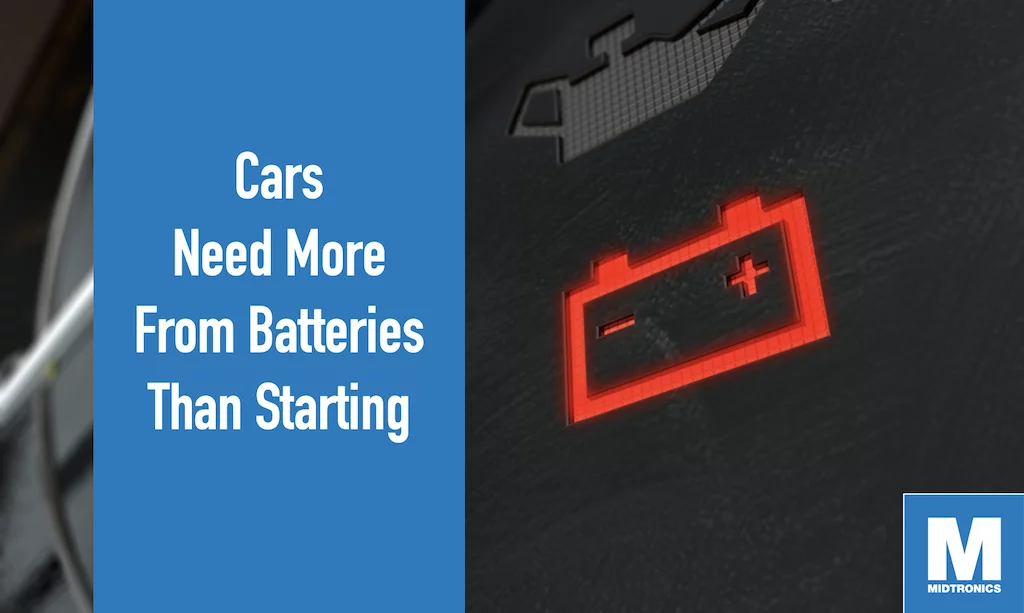The most common use for a car battery over the past century has been to start the engine. It’s still the predominant reason vehicles of all types are equipped with a 12-volt battery, and with technology like Auto Start-Stop, it’s even more important to have a good battery installed.
However, that’s not the only reason for having a 12-volt battery. And in addition to long-standing reasons, recent developments in in-vehicle technology require that your car battery stays in good shape to prevent an unexpected failure. That changes how you should think about battery diagnostics too.
Non-starting applications for car batteries
Search results online regarding a car battery’s function are dominated by starting-related explanations. But that leaves several reasons out of the picture and, arguably, they’re just as important as cranking the starter over.
Accessory power with the engine off
From the dawn of automobiles, anything that’s connected to the electrical system that can operate with the engine off can and will draw down its power storage. Accessories like power windows, heater fans, infotainment systems, and lights normally take their power from the alternator when the engine is on, but they draw from a battery’s reserve if it’s not running. And as cars are equipped with more computers, additional draw occurs even as they ‘sleep’.
Fast recharging
There are around three times as many start cycles for vehicles with Auto Start-Stop technology. Even when a battery can handle all that cranking, it must be able to accept the charge from the alternator fast enough to replenish the battery’s reserve capacity and amperage. High-rate charge acceptance is the requirement here, and if a battery isn’t capable anymore, fuel economy suffers as there isn’t sufficient remaining capacity for the vehicle to initiate a Start-Stop cycle at a stop.
Voltage regulation
Overcharging is notoriously bad for cars, resulting in damaged circuits and computer module problems especially. The battery acts to regulate voltage to some degree, preventing voltage spikes that could cause frustrating and hard-to-diagnose electrical issues in the car.
Alternator health
The loud whine of an engine that’s been jump-started is the alternator furiously trying to replenish the battery’s charge. For a battery that has deteriorated cranking health or reserve capacity, the alternator works harder than normal between starts while simultaneously delivering the necessary power to the rest of the car’s electronics. That added stress can cause it to fail unexpectedly.
EV’s non-drive systems
And for full electric vehicles, the 12-volt battery obviously isn’t used for starting at all. Its role is to power the accessories as well as safety systems and lighting. The EV’s large battery pack takes care of propulsion, and converts a portion of that power to recharge the 12-volt battery. If the 12-volt battery isn’t up to par, it can begin to affect how your EV operates.
What does that mean for battery diagnostics?
A glance at a voltage gauge on the dash hasn’t been an accurate reading for battery health at the best of times, and it still isn’t. Similarly, checking a scan tool for voltage-related codes or to monitor the charging rate can provide false confidence that the battery is in good condition.
For technicians, fleet managers, and vehicle owners today, more advanced battery diagnostics should be used to determine whether a battery is in good health or needs to be replaced. Here’s why.
Voltage testing isn’t enough
A heavily sulfated battery isn’t visible to the naked eye, and it can be recharged to a completely normal 12.6 or 12.7 volts. Voltage is a key indicator if an engine will crank over in that moment, but it only provides a single data point; it doesn’t even consider length of cranking time.
Using a multimeter of an OBDII scan tool to check voltage misses the crucial information in a cranking health check. You need to know the cranking amperage, especially as it relates to the battery’s rating.
Reserve capacity is more important than ever
Listening to the radio with the engine off, setting up a campsite in the dark with the headlights on, and using the 12-volt outlet to charge devices or use a compressor are just as common today as in the past. Since it draws from the battery’s reserve capacity, a weak battery could die in a short time. For vehicles in recent years, reserve capacity determines whether Auto Start-Stop will happen when you come to a stop, and for how long the engine will remain off at a time.
Reserve capacity is only tested when there’s a load applied to the battery in the process. It’s a component of most battery tests, but it’s more important than ever to pay attention to reserve capacity results, even if the cranking health checks out.
Charge acceptance should be assessed
Just one decade ago, virtually all vehicle engines would run constantly between when they were started and when you reached your destination, allowing for a slow, methodical battery charge from the alternator. Today’s vehicles don’t have the luxury of a slow recharge rate anymore. With Auto Start-Stop, a single half-hour commute could have 10 or more start cycles required, and the battery needs to be able to accept faster and higher-rate charges. That’s why AGM and EFB batteries are used for these applications.
If the charge acceptance rate isn’t assessed for EFB and AGM batteries, it overlooks an area that could eventually find the battery low on charge, or there could be issues with the start-stop functionality. It’s a component of battery health that’s much more prevalent – and important – than any other time.
Shops should be equipped to perform battery tests on all areas of battery health, not just for starting purposes. Make sure you have battery diagnostic equipment capable of checking overall state of health that includes charge acceptance along with CCA and RC like the Midtronics DCA-8000.




